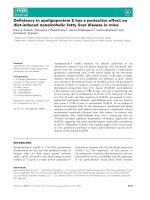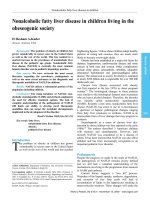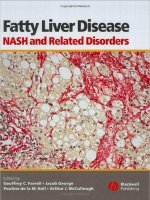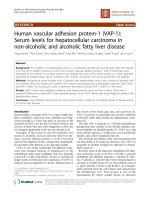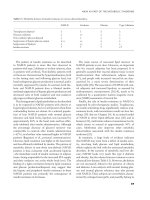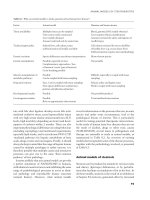optimizing nonalcoholic fatty liver disease care using mac2 binding protein glycosylation isomer and correlations with advanced diagnostics
Bạn đang xem bản rút gọn của tài liệu. Xem và tải ngay bản đầy đủ của tài liệu tại đây (5.59 MB, 30 trang )
<span class="text_page_counter">Trang 1</span><div class="page_container" data-page="1">
Optimizing non-alcoholic fatty liver disease care using mac-2 binding protein glycosylation isomer and correlations with
</div><span class="text_page_counter">Trang 2</span><div class="page_container" data-page="2">Global rates of NAFLD increasing over time
<small>Zobair M. Younossi et al. THE GLOBAL EPIDEMIOLOGY OF NAFLD AND NASH. Hepatology. 2023;77:1335–1347. </small>
I. Background.
</div><span class="text_page_counter">Trang 3</span><div class="page_container" data-page="3">Prevalence of NAFLD According to Global Regions Data Collected 1990–2019
<small>Zobair M. Younossi et al. THE GLOBAL EPIDEMIOLOGY OF NAFLD AND NASH. Hepatology. 2023;77:1335–1347. </small>
</div><span class="text_page_counter">Trang 4</span><div class="page_container" data-page="4">Natural history of NAFLD: from liver steatosis to HCC
<small>Desjonqueres et al. Hepatoma Res 2022;7:16 </small>
</div><span class="text_page_counter">Trang 5</span><div class="page_container" data-page="5">Global burden of cirrhosis and liver cancer due to NASH from 1990 to 2050
(A) Incidence number of cirrhosis due to NASH; (B) Prevalence number of cirrhosis due to NASH; (C) Death number of cirrhosis due to NASH; (D) DALYs number of cirrhosis due to NASH; (E) Incidence number of liver cancer due to NASH; (F) Prevalence number of liver cancer due to NASH; (G) Death number of liver cancer due to NASH; (H) DALYs number of liver cancer due to NASH.
<small>NASH: nonalcoholic steatohepatitis; DALYs: disability-adjusted life years. Dash line: forecasted NASH burden from 2018 towards 2050 through ARIMA model.</small>
<small>Tianyue Zhang et al. Journal of Cancer 2021, Vol. 12 (10): 2855-2865. </small>
</div><span class="text_page_counter">Trang 6</span><div class="page_container" data-page="6">Global burden of cirrhosis and liver cancer due to NASH by age in 2017
<small>(A) Prevalence number of cirrhosis due to NASH; (B) DALYs number of cirrhosis due to NASH; (C) Prevalence number of liver cancer due to NASH; (B) DALYs number of liver cancer due to NASH.</small>
<small>NASH: nonalcoholic steatohepatitis; DALYs: disability-adjusted life years. </small> <sub>Tianyue Zhang et al. Journal of Cancer 2021, Vol. 12 (10): 2855-2865. </sub>
</div><span class="text_page_counter">Trang 9</span><div class="page_container" data-page="9">M2BPGi is a new Direct Biomarker to diagnostic Liver Fibrosis
</div><span class="text_page_counter">Trang 10</span><div class="page_container" data-page="10">Summary table for the value of conventional and elastographic imaging modalities in non-alcoholic fatty liver disease stratification.
<small>Li Q, Dhyani M, Grajo JR, Sirlin C, Samir AE. Current status of imaging in nonalcoholic fatty liver disease.World J Hepatol2018; 10(8): 530-542</small>
</div><span class="text_page_counter">Trang 11</span><div class="page_container" data-page="11">• - Investigate M2BPGi levels according to age groups and genders, and diabetes.
II. Objectives and Method.
</div><span class="text_page_counter">Trang 12</span><div class="page_container" data-page="12">Hepatology department: Screening and Recruitment
<small>Inclusion: - ≥ 18 yo</small>
<small>- Diagnosed fatty liver by imaging: abdominal US or CAP on fibroscan - Nạve treatment for NAFLD or cease treating more than 6 months - Appropriate to perform MRE</small>
<small>Exclusion: </small>
<small>- Co-infection HBV & HCV - Pregnant </small>
<small>- Any underlying cancers </small>
<small>- Alcohol intake: >30g/day (male) and > 20 g/day (female) - End-stage renal disease (ESRD)</small>
<small>- Inapproriate samples, such as severe hemolysis, high turbidity </small>
<small>F0/1 (n=90)F2 (n= 73)F3 (n=95)F4 (n=43)</small>
Enrollment
<small>Routine lab tests</small>
<small>- CTC- LFTs- FIB-4- M2BPGi</small>
Imaging diagnostic: MRE
<small>Major analysis</small>
<small>- Define cut-off values of M2BPGi of each stage</small>
<small>- Perform correlation between M2BPGi and MRE, Fibroscan, and FIB-4- Sub-population analysis: age groups, diabetes, and genders</small>
Objectives and study diagram
<small>Statistic: Graphpad Prism version 10.1 </small>
</div><span class="text_page_counter">Trang 13</span><div class="page_container" data-page="13">Descriptive statistics of M2BPGi according stratified fibrosis stages
</div><span class="text_page_counter">Trang 14</span><div class="page_container" data-page="14">Diagnostic efficacy of serum
M2BPGi and other serum markers for different liver fibrosis stages
<small>Jang SY, et al. Ann Lab Med 2021;41:302-309 </small>
<small>Abbreviations: AUC, area under the curve; APRI, aspartate aminotransfer ase to platelet ratio index; F, fibrosis; FIB-4, fibrosis index based on four fac tors; NAFLD, non-alcoholic fatty liver disease; NFS, NAFLD fibrosis score; M2BPGi, Mac-2 binding protein glycosylation isomer. </small>
</div><span class="text_page_counter">Trang 15</span><div class="page_container" data-page="15">Median of M2BPGi levels across fibrosis stages in overall and by genders
</div><span class="text_page_counter">Trang 16</span><div class="page_container" data-page="16"><small>Tobari M and Hashimoto E. Gut and Liver, Published online January 3, 2020 </small>
Distribution of patients with nonalcoholic fatty liver disease by mild or advanced fibrosis status with respect to age and sex
In the older generation, advanced fibrosis was more common than mild fibrosis in both sexes. Data was obtained from Tokyo Women’s Medical University in 1991 to 2018 (n=811: 406 men and 359 women).
</div><span class="text_page_counter">Trang 17</span><div class="page_container" data-page="17">The percentage of cirrhotic NAFLD was higher in women than in men (56% vs 44%), while the percentage of HCC was higher in men than in women (69% vs 31%)
Percentage of male and female patients with a diagnosis of nonalcoholic fatty liver disease (NAFLD), cirrhosis, or hepatocellular carcinoma (HCC)
<small>Tobari M and Hashimoto E. Gut and Liver, Published online January 3, 2020 </small>
</div><span class="text_page_counter">Trang 19</span><div class="page_container" data-page="19">Median of M2BPGi levels across fibrosis stages by ages and w/wo diabetes
</div><span class="text_page_counter">Trang 20</span><div class="page_container" data-page="20">The percentages of fibrosis stages compared between elderly and non-elderly NAFLD patients
Elderly NAFLD patients had significantly more patients with advanced fibrosis (F3–4; 35.4% vs. 13.4%; P < 0.01)
<small>Panyavee Pitisuttithum et al. BMC Gastroenterology (2020) 20:88 </small>
</div><span class="text_page_counter">Trang 21</span><div class="page_container" data-page="21">Type 2 diabetes and obesity aggravate the progression of NAFLD/NASH to HCC
<small>Hyunmi Kim et al. Int. J. Mol. Sci. 2021, 22, 4495 </small>
</div><span class="text_page_counter">Trang 24</span><div class="page_container" data-page="24">Correlation between MRE and other parameters
</div><span class="text_page_counter">Trang 25</span><div class="page_container" data-page="25">Diagnostic performance of M2BPGi and FIB-4 in significant fibrosis
</div><span class="text_page_counter">Trang 26</span><div class="page_container" data-page="26">Diagnostic performance of M2BPGi and Fib-4 in cirrhosis
</div><span class="text_page_counter">Trang 27</span><div class="page_container" data-page="27">Liver fibrosis marker values at each liver fibrosis stage in NAFLD patients.
<small>Jang SY, et al. Ann Lab Med 2021;41:302-309 </small>
Spearman’s rank correlation analysis showed that the serum M2BPGi level (ρ=0.653, P<0.001) and FIB-4 (ρ=0.689, P<0.001) increased with the liver fibrosis stage. There were moderate correlations between APRI (ρ=0.515, P<0.001) and NFS (ρ=0.628, P<0.001) and fibrosis stage, respectively. However, the median APRI score decreased in F4 than in F3, and median NFS decreased in F1 than in F0.
(A) Serum M2BPGi level, (B) APRI, (C) FIB-4, and (D) NFS. The box height represents the
interquartile range, and the line across each box represents the median.
<small>Abbreviations: APRI, aspartate transaminase to platelet ratio index; FIB-4, fibrosis index based on four factors; M2BPGi, Mac-2 binding protein glycosylation isomer; NAFLD, non-alcoholic fatty liver disease; NFS, NAFLD fibrosis score; ns, not significant. </small>
</div><span class="text_page_counter">Trang 28</span><div class="page_container" data-page="28">